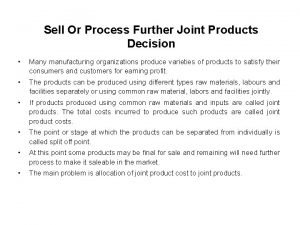Sell Or Process Further Joint Products Decision Many





- Slides: 5

Sell Or Process Further Joint Products Decision • Many manufacturing organizations produce varieties of products to satisfy their consumers and customers for earning profit. • The products can be produced using different types raw materials, labours and facilities separately or using common raw material, labors and facilities jointly. • If products produced using common raw materials and inputs are called joint products. The total costs incurred to produce such products are called joint product costs. • The point or stage at which the products can be separated from individually is called split off point. • At this point some products may be final for sale and remaining will need further process to make it saleable in the market. • The main problem is allocation of joint product cost to joint products.

Sell or Further Process decision • Therefore, there are various techniques and methods for allocation of joint cost to each product. • The main techniques are unit method, sales value method, net realization value less normal profit method, and weighted average method. • However, the mostly used approach in allocating joint cost is the proportion of its sales value method. • Therefore, joint cost can be allocated to each joint product on the proportion of the market value/sales value of the product.

Continued • Sell or process further decision is a decision as to whether joint products should be sold at split off point or further process and sell them in different form. • In this decision, joint costs are irrelevant and remain unaffected because they are sunk cost. • Generally, selling products after processing further will be more profitable than selling at split off point. • However it is not necessary to be profitable. It may also be less profitable.

• In sell or further process decision, comparative statement of alternatives or incremental statement should be prepared. • If total net income after processing further is greater than net income under selling at split off point, then further processing will be more attractive and vice versa. Sometimes, products will be more profitable to sell at split off than selling after processing further. • In order to maximize the profitability of the organization, sometimes, some products should be sold at split off point and remaining after processing further.

CASE: Rolex Company manufactures three products from a common input in a joint processing operation. Joint processing costs up to the split–off point total $100, 000 per year. The company allocates these costs to the joint products on the basis of their total sales value at the split–off point. These sales values are: product X, $50, 000; product Y, $90, 000; and product z, $60, 000. Each product may be sold at the split–off point or processed further. Additional processing requires no special facilities. The additional processing costs and the sales value after further processing for each product (on an annual basis) are: Product Additional Processing Costs Sales Value X Y Z $ 35, 000 40, 000 12, 000 $ 80, 000 150, 000 75, 000 Required: Which product or products should be sold at the split–off point, and which product or products should be processed further? Show computation









